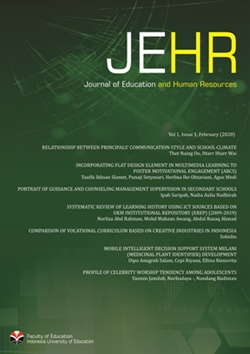The International Journal of Education and Human Resources (JEHR) is an open access and peer-reviewed journal, published by Universitas Pendidikan Indonesia, which is a dissemination medium for research result from scientists in fields of education and human resources. JEHR is a biannual journal issued on February and August
The editors welcome submissions of papers describing recent theoretical and experimental research related to: (1) Theoretical articles; (2) Empirical studies; (3) Case studies; (4) Review of papers, books, and resources.

Vol 2, No 2 (2021)
Table of Contents
Articles
|
Jaka Fathin Ammar, Achmad Hufad, Wilodati Wilodati
|
|










